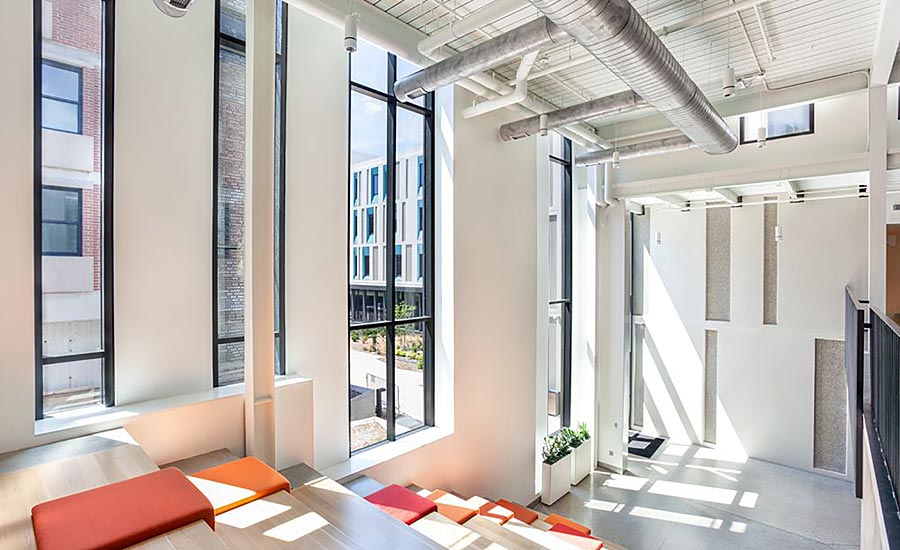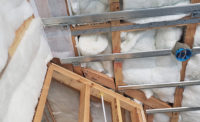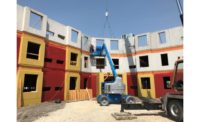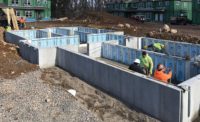You might describe precast concrete construction as “controlled efficiency.” While weather conditions, supply chain disruptions and labor availability can all threaten to throw a project off course, a Midwestern residence hall housing future artists demonstrates the efficiency precast concrete construction offers for enclosures that must meet stringent performance criteria, tight production schedules, and discerning occupants.
The Barbara A. Marshall Residence Hall at Kansas City Art Institute is an award-winning example of precast construction. The project team integrated 3 C’s—concrete, collaboration, and color—to achieve a building that achieved aesthetic design goals, thermal performance and construction efficiency.
Considering the artistic profile of the residence hall’s occupants and the aggressive timetable for construction helped inform the choice of precast concrete panels for the enclosure. There was also thermal performance to consider in a climate that vacillates between sultry summers and bone-chilling winters. According to the National Precast Concrete Association, precast concrete can support fast installation to address challenging job site restrictions, ensure water tightness, create a desired look, or achieve complex customizations. But the real proof is always in the pudding. Or in this case, the finished project and the ability of team members to work together to achieve the desired outcome.
Collaboration early in the process between architect Helix Architecture + Design, contractor JE Dunn Construction and Enterprise Precast Concrete led to a design offering visual impact that appeals to the artists in residence while supporting comfort and transparency in design. Project management and labor considerations also influenced the design strategy, as the aggressive timeline and efforts to efficiently schedule team members’ time on the jobsite presented challenges.

The Efficiencies, Performance and Control of a Precast Approach
Design and material choice worked hand in hand to meet the residence hall’s efficiency and performance goals. The frame is comprised of cast-in-place concrete. An Altus Group CarbonCast C-GRID carbon fiber grid contributes to the enclosure’s strength and thermal efficiency of the enclosure. A 4-inch layer of Owens Corning FOAMULAR 250 extruded polystyrene (XPS) insulation is sandwiched between two wythes of concrete. XPS insulation delivers a continuous layer of insulation without thermal breaks, contributing to a comfortable environment in all seasons.
“The facility team wanted a complete wall panel solution and an insulated precast sandwich fit the bill,” says Dirk McClure, business development director at Enterprise Precast Concrete. Altogether, 222 precast wall panels were installed in the residence hall. The team specified large panel sizes to minimize the number of pieces transported on site. Panels were fabricated in an indoor production facility under controlled climate conditions, then shipped by flatbed truck to the job site where they were placed by crane into the concrete cast-in-place frame. This highly efficient process supported a panelized, modular approach to the enclosure’s construction that integrated the thermal barrier into a strong and simple solution. Compared to a traditional wall assembly requiring multiple components, this design is much more efficient.
Logistics, sizing and movement of components on the job site factored into the design. Panels were shipped vertically and were light enough to be lifted by a tower crane. The heaviest piece was about 17,500 pounds. A diagram was created to show how the crane would manage to swing all the panels from one location.
Artistic Considerations for Art-Minded Occupants
While concrete is respected for its strength and resilience, it also adds design intrigue in the Barbara A. Marshall Residence Hall and is a natural complement to other campus buildings. The Museum of Art to the west, another student living center to the east, and a notable sculpture north of the residence hall all use concrete as the primary material. An ‘honesty of materials’ effect is advanced with precast panels with an exposed concrete face. Precast assembly delivered an added benefit of leveraging fabrication to introduce a level of texture and design interest in a controlled environment protected from the outdoor elements.
The residence hall’s insulated panels can absorb the severe taper of exterior windows which provide a defining design statement to the façade. A fluid applied stain add pops of color in combination with an acid etching and a retarder finish, delivering a striking visual effect. And because the exposed sandblasted precast reduces how much indoor space is painted, the design contributes to sustainability efforts and reduces VOCs.
The honesty of materials theme isn’t restricted to the exterior. The interior wythe of concrete is largely structural gray and left exposed with a sandblast finish. This sandblast effect is carried out in the corridor, study alcoves, gym area and on the interior walls of students’ suites/rooms. It is also echoed by exposed concrete in various open spaces, select interior walls and a vibrant fireplace space. Respecting its role as a temporary home, the interior evokes comfort. The same space that offers a sense of warmth in winter, feels cool and relaxing in the summer. A series of vibrant color precast panels throughout the interior create a sense of continuity between interior and exterior. This effect is especially visible in the panel on the back wall of the grandstand tiered seating area.
Optimizing Material Performance
Sustainable design was integrated at the outset of the project. “Project team members included LEED and WELL accredited professionals who sought to make the building as healthy and sustainable as possible while working within the constraints of the site and project budget,” says McClure. Sefaira energy modeling was used to optimize energy performance. The use of pre-cast concrete and XPS insulation delivers high thermal insulation value, recycled content and no waste. With a nod to extreme weather, a storm water basin helps manage storm water run-off while the use of native plants reduces the need for water and helps manage storm water.
Considering the logistic decisions that supported the project’s efficiency, Brad Hulse of JE Construction credits early and frequent communication. “Early preconstruction efforts with everyone involved: Architect, contractor and precaster helped the project stay on track and achieve success,” Hulse says.
David Fincham, regional sales manager at Owens Corning, says that collaboration and communication between the company’s XPS team and Enterprise Precast contributed to a successful project. “Design integrity and construction efficiency must work hand in hand, and that’s where a trusted partnership between the project managers at Enterprise Precast and the manufacturer really shined,” says Fincham. Learnings from earlier collaborations– such as the timing of insulation deliveries to the production facility—helped the project meet an aggressive casting schedule. “While this residence hall is a great example of insulation delivering thermal performance, it also demonstrates how precast concrete supports an efficient, high performing approach to façade construction and a higher degree of control and predictability regardless of weather,” Fincham says.
The residence hall’s construction speaks to the efficiency that precast construction offers—especially in a tight job market. One ongoing trend is an effort to have fewer workers on jobsites and to get workers in different trades on and off the jobsite as quickly as possible. “With a crew of about a half-dozen people—a superintendent, foreman, some ironworkers and a crane—you can install an entire building façade,” McClure says. The project highlights the importance of efficiency and precision in labor scheduling. Fabricated components allow production to continue even during inclement weather. As long as the footings and foundation are in place, precast panels can be installed all year round.
While the Barbara A. Marshall Residence Hall is remarkable when looked at through the lens of efficiency and sustainability, it is also impressive when viewed through the eyes of critics— or judges to be more precise. The project’s accolades include numerous awards, including AIA 2020 Kansas City 2020 Project of the Year.
The Barbara A. Marshall Residence Hall at the Kansas City Art Institute presents a concrete solution for merging design aesthetics, thermal performance and project management for artists in residence. Remarking on the residence hall honoring her mother’s contributions to the arts, Margaret Silva says, “My mother always had a deep appreciation for artists. She respected the artist and their process as highly as the work itself. Her respect for the mission of the college brought her to want to help create an environment to nurture students and develop their creative talents. Through the generosity of so many, KCAI now has world class facilities to do that.”
And while art can often be considered abstract, this residence hall is concrete evidence that efficiency, aesthetics and performance can combine in a beautiful project.





Report Abusive Comment